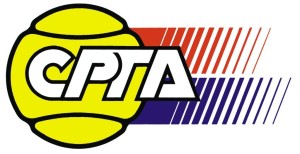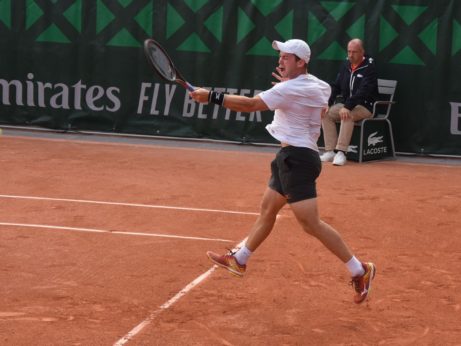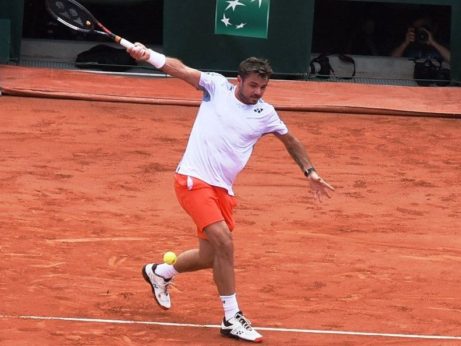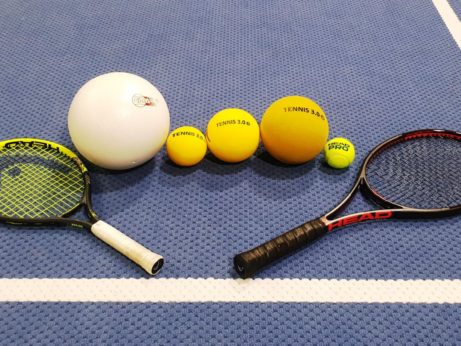TENNIS 3.0 CODE – for TENNIS 3.0 strokes – general information

UPDATED – TENNIS 3.0 CODE developed after more than two decades of research, is a comprehensive set of very logical and easy to follow technical/mental reference points/guidelines (algorithms) for each tennis stroke leading to the ball striking action with the dominance of the body energy upon the racket/ball = TENNIS 3.0 style of play.
Very high degree of the TENNIS 3.0 fulfillment in most of their strokes is then one of the main reasons for the dominance of the players like Serena Williams, Rafael Nadal, Roger Federer and Novak Djokovic over majority of the other tour players, which in contrary tend to play quite a high amount or even majority of their strokes rather with the arm energy dominance (= Tennis 2.0). In general, the higher the degree of the TENNIS 3.0 fulfillment in each stroke and the higher the percentage of the TENNIS 3.0 strokes in the game, the better the chances for success and also for further development/growth of the players at almost any age and level. The above written is valid for most standard strokes in the game, certain trick and troubleshooting actions have their own rules, where parts of the TENNIS 3.0 CODE might be not used. But in general, the better the player, mostly the lower trouble-shooting percentage of strokes is being used in the course of a match.
Many of the biggest tennis stars of all time (Rod Laver, Jimmy Connors, Martina Navratilova, Boris Becker, etc.) started with a very specific TENNIS 3.0-like style of play in their very young age already, developing/programming the winning algorithms for/around their strokes and many essential playing actions in their minds early and thus in a “hard-wired” sense. On the other side, most of the juniors playing for years in the arm action dominated Tennis 2.0 style, despite sometimes very successful junior career, hardly ever came to any significant success on the professional tour level. In general, practically all of the players, who have been able to constantly dominate the game for many years, discovered by themselves or have been taught certain version or parts of the TENNIS 3.0 CODE, most probably based rather on experience than on extensive research data as it’s the case in this CPTA project.
The TENNIS 3.0 CODE is then closely tied to the “3 Step Tennis Stroke Regulation” where:
Step #1 is the creation of the space necessary for optimal body engagement in the stroke making optimal body pretension and balance during the stroke as well as the free swinging of the racket possible. Full mental engagement, as well as eye focus resulting in a good processing of the incoming ball, play also a big role here. The ball processing and space creation are then largely influenced by the stored images of the optimal stroke solutions (if the TENNIS 3.0 CODE is incorporated in these), footwork capacity and overall fitness level of the players.
Step #2 is the arm action, which should, given the ideal situation of sufficient space available, focus mainly on keeping the follow through going as long as reasonably possible against the target. In the case of an insufficient space/time, the arm action focuses, often almost independently for the body action, on the troubleshooting action. As already stated above, the better the players, the less troubleshooting arm action can be observed.
Step #3, sometimes also called invisible technique, is the proprioceptive regulation of the muscle tension (in all involved body parts) and specifically tightness of the grip, which determines how much of the developed energy is being transferred upon the racket or better to be said, how much “energy backing” does the racket have during the impact. The very best players are masters of this regulation. In contrary, players with excessive arm action in the step #2 have difficulties to ideally use step #3 regulation.
TENNIS 3.0 CODE has few respective requirements to be followed in the step #1 and step #2 in each of the strokes of tennis. But there is the one main element of the TENNIS 3.0 CODE, which is common to all dynamic TENNIS 3.0 strokes being hit with the optimal combination of power and control (with the exception of some troubleshooting and trick strokes), which we want to reveal to the tennis world – the common denominator of all high-quality dynamic TENNIS 3.0 strokes is in the effort to move the elbow (can be also understood as the upper arm, like late Vic Braden used to call it) as far as possible away from the body core towards the target during and shortly after the impact!!! This main element then needs to be applied in the context of the supporting actions, which all together build the TENNIS 3.0 CODE for each respective TENNIS 3.0 stroke. For the best possible outcome, the players need to know how to move the elbow away from the core towards the target in the most efficient way and how to well control the timing of this process.
The “elbow away from the body core towards the target rule” applies to all strokes – forehands, backhands (both one-handed – right elbow and two-handed – left elbow), slices, volleys, drop shots, overheads and services, besides, as already mentioned, some extreme troubleshooting and some trick strokes!
Below, a high degree of body engagement similarity in their two-handed backhands can be seen between the then not even 6-year old Ewa (*2009 / POL) and back then a top 10 player Eugenie Bouchard (*1994 / CAN), with both of them (both having similar TENNIS 3.0 CODE information on their disposal) the body action/energy dominates the racket action and thus also the racket position in the space = TENNIS 3.0. In contrary, the further below photos of the Czech junior Monika Kilnarova (*1999 / CZE) and Swiss junior Vanessa Zemp (*1997 / SUI), who don’t seem to have the knowledge of the TENNIS 3.0 CODE, show two-handed backhand strokes where the arm action dominates the racket = Tennis 2.0. Needless to say, a majority of the junior tennis players worldwide, unaware of the TENNIS 3.0 CODE, play rather in the Tennis 2.0 style, which seriously limits their further development potential. Talented players with skillful arm coordination can or rather were able to win with Tennis 2.0 strokes many junior titles including junior Grand Slams, but their chances on the professional tour were/are rather limited.
Even further below are examples of top players who seem to have certain TENNIS 3.0 CODE knowledge in their respective top strokes. Needless to say, some top players can hit very good TENNIS 3.0 strokes, which are later followed by the strokes missing the main TENNIS 3.o elements. This situation means that they are mostly missing the exact deep knowledge of the TENNIS 3.0 CODE or some of its elements.
More information about TENNIS 3.0 and specific TENNIS 3.0 CODE elements for each stroke are available for qualified parties upon request at drmgb11(at)gmail.com

Ewa (5y 8m / POL) – Two-handed Backhand 3.0 with the DTBT foam ball FB-90 Green in the practice – follow through 1 = targeted pronation – body energy dominates the action and also the position of the racket in the space, the non-dominant (here left) elbow is reaching the almost biggest possible distance from the body core towards the intended target – all 3 regulation steps have been done correctly – Aesch / Switzerland – Spring 2015

Eugenie Bouchard (*1994 / CAN) – Two-handed backhand in 3.0 style during the practice – end of follow through 1 – body energy dominates the stroke and position of the racket in the space, non-dominant (here left) elbow is similar like in Ewa’s case above reaching practically the longest possible distance from the body core towards the target – 2014 US.Open – New York / USA

Monika Kilnarova (*99 / CZE) – Two-handed backhand 2.0 style – beginning of follow through 1 – arm action dominates to big degree the stroke and racket position/behavior (= no TENNIS 3.0 CODE in action here), the non-dominant (left) elbow is staying very close to the body core – 2015 Orange Bowl – Plantation, FL / USA

Vanessa Zemp (*97 / SUI) – two-handed backhand – end of follow through 1 of a stroke without body energy dominance of the racket (= not complete TENNIS 3.0 CODE in action) – Vanessa understands the need of moving the elbow against the target, but the energy of the body doesn’t support this aim – one of the very typical mistakes, even at the highest professional level – ITF Juniors Luzern – 2014

Timea Bacsinszky (*89 / SUI) – Two-handed backhand in the match – Timea’s main weapon – 1 of 2 – push-off – perfect fulfillment of the 1st stroke regulation step (=space creation) – 2017 French Open – Paris

Timea Bacsinszky (*89 / SUI) – Two-handed backhand in the match – 2 of 2 – follow through 1 – non-dominant (left) elbow flies away from the body towards the intended target, body energy dominates the action – perfect 2nd regulation step – 2017 French Open – Paris

Martina Navratilova (*56 / USA-CZE) – 1st service 3.0 in the match – targeted follow through 1 – the elbow clearly above the shoulder and far away from the center of gravity is a typical sign of the Service 3.0 – 1996 WTT Finals – Saddlebrook, FL / USA

Novak Djokovic (*87 / SRB) – 1st service 3.0 in the match – targeted follow through 1 – elbow high above the shoulder and far from the body core – 2010 US.Open – New York

Gael Monfils (*86 / FRA) – 1st service 3.0 in the match – targeted follow through 1 with the elbow high above the shoulder and far away from the center of gravity towards the target – 2016 US.Open – New York / USA

Serena Williams (*81 / USA) – Forehand 3.0 in the practice – follow through – here, Serena clearly puts focus at moving the elbow and the racket against the intended target – 2003 French Open – Paris

Serena Williams (*81 / USA) – Forehand 3.0 in the practice – follow through – Serena is very aware of the elbow distance from the body core – 2014 US.Open – New York

Rafael Nadal (*86 / ESP) – Forehand 3.0 in the practice – targeted follow through 1 – big elbow distance from the body core – many observers focus at the buggy whip, which is often rather an idiosyncrasy, and miss the deciding element – 2010 US.Open – New York

Marin Cilic (*88 / CRO) – Forehand 3.0 in the practice – targeted follow through 1 – elbow flies far away from the body core towards the intended target – Marin won the tournament that year – 2014 US.Open – NYC

Martina Hingis (*1980 / SUI) – Forehand Volley 3.0 – elbow powered by the body energy travels far away from the body core towards the target – Biel / Switzerland – April 2017

Martina Hingis (*1980 / SUI) – Drop volley 3.0 in a match – 1 of 2 – early follow through – even here, Martina powers the racket by the body energy and moves the elbow away from the body core – all three stroke regulation steps in a full harmony – Biel / Switzerland – April 2017

Martina Hingis (*1980 / SUI) – Drop volley 3.o in the match – 2 of 2 – relaxation phase – Biel / Switzerland – April 2017

“Three Step Tennis Stroke Regulation” can be seen as a certain “gold standard” of sustainable high-quality tennis strokes
This article mentions mainly the general rules around the TENNIS 3.0 CODE. For more information as well as for exact codes for each tennis stroke, please contact drmgb11(at)gmail.com.
Photos (1996-2017) and text (2016-2017) copyright by Dr. Martin G. Baroch. Any further presentation of either photos or text with written permission of the author/copyright owner only!




